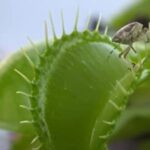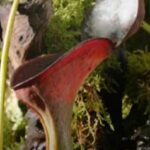As an Amazon Associate, this site earns commissions from qualifying purchases. For more details, click here.
Pitcher plants are a source of fascination, both for their appearance and ability to trap and eat insects. One thing that holds prospective buyers back though, is the thought that they are hard to grow. But keeping pitcher plants alive is actually quite simple if you ask long time owners. But can a beginner handle it?
Caring for pitcher plants is easy if you provide the basic requirements. These plants need 6-8 hours of sunlight, moist soil, high humidity and should be fed at least once a month. Sarracenia pitcher plants go dormant and suitable outdoors, while nepenthes are tropical plants and thrive indoors.
Where to Grow Pitcher Plants
The easiest pitcher plants to keep alive are the ones native to your area. These plants become difficult to cultivate if you raise them in an environment that is different from what they are used to.
Nepenthes pitcher plants are tropical. They prefer warm, humid temperatures all year round. They cannot survive the cold winter freeze so they should be raised indoors. You can grow nepenthes outdoors but only during spring, summer and early fall.
Sarracenia on the other hand, bloom in spring and go dormant in winter. These plants will emerge from dormancy with proper care so they are best for the outdoors. You can nurture sarracenia indoors, but they require lots of sunlight. During winter, you have to take the plant outdoors so it can go through dormancy.
Knowing what type of pitcher plant you have is the first step. Next, get familiar with its natural habitat and try to replicate that. Even if it is not 100% the same, the most important elements have to be present. The following sections provide more tips on keeping pitcher plants healthy and thriving.
Use the Right Soil For Pitcher Plants
Pitcher plants are only found in areas without nutrition. Because the soil is devoid of nutrients, the plants seek out live prey which possesses them.
Pitcher plants will only survive in poor soil. Use perlite and peat moss or long sphagnum fiber and silica sand. These plants cannot absorb nutrients in fertilized media. For an easier solution we like the Doter Sphagnum Moss Potting Mix because you can use it right away.
If you buy a potted pitcher plant, you will see that the soil contains no nutritional elements. For best results, use the same materials for propagation. The best time to propagate is when the plant emerges from dormancy. You can use seeds, leaf or root cuttings.
Pitcher plants grow well in plastic containers and pots as long as there is good drainage. A 5 inch pot is enough but larger species will benefit from a 7-10 inch container.
Rich soil is fatal to pitcher plants so avoid them. Carnivorous plants have adapted so well to poor soil they cannot grow in rich potting media. Because pitcher plants get nutrition from insects the soil is used in relation to water, humidity and as a support base. For more details, here is a detailed guide on what types of soil to use for pitcher plants.
How to Water Pitcher Plants
Nepenthes can be watered from the top until the soil is moist. Sarracenia pitcher plants however, can handle more water especially during summer. You may use the tray method on sarracenia with about an inch of water.
Keep in mind there are many pitcher plant variants, and some need more water than others. There are over a hundred nepenthes species alone. The general rule is to maintain the moistness of the soil at all times.
Use only purified water, rainwater or reverse osmosis. Using tap water can kill the plant or shorten its lifespan significantly. Water is essential for all plants and pitcher plants are no exception. They need plenty of it but you have to avoid drenching the soil so balance is key.
If you are having a hard time keeping nepenthes alive and use tap water, now you know why. The chemicals in the water is too high for plants to tolerate. Rainwater is the best but distilled, purified, spring and reverse osmosis will also do fine.
Nutrition and Food
There is a bit of confusion about food and nutrition so let us clear things up here. This is very important for pitcher plants particularly when they are growing.
Pitcher plants need food and nutrients to reach their maximum growth potential. They can produce food by using photosynthesis, while nutrition comes from insects, bugs or other foods like fish pellets and freeze dried worms.
If you grow sarracenia outdoors, the plant will catch plenty of insects including spiders, flies, wasps and even crickets Just make sure the plant has access to direct sunlight and you do not have to worry about its nutrition intake.
If you have nepenthes indoors, the best options are fish pellets or freeze dried mealworms. You can also feed them live or dead insects, but fish food and frozen / freeze dried mealworms and bloodworms are easier to get. A lot of pitcher plants respond well to Downtown Pet Supply Dried Mealworms so we recommend that.
Pitcher plants do not require a lot of food. With plenty of sunlight they can produce glucose and meet most of their requirements. In most cases, you can feed nepenthes 1-2 bugs a month, depending on its size. You can nourish it every 1-2 weeks too.
Light Requirements
Nepenthes need at least 6 hours of sunlight every day. They are tropical plants and require the same amount of light all year round. If your nepenthes is outdoors, take it inside before winter comes and use artificial light for at least 8 hours a day.
Sarracenia need at least 6 hours of direct sunlight daily. Nepenthes is fine with direct and partial light, but sarracenia do not grow well under partial lighting.
You can try grow lights on sarracenia but it may not respond as well compared to sunlight. This is why they should be outdoors to get as much natural light as possible. Because sarracenia are dormant in winter, their light requirements go down. Just leave the plant outdoors as that is their natural habitat in winter.
The Best Temperature and Humidity For Pitcher Plants
Majority of nepenthes prefer the temperature to be at least 65 F and no more than 85 F. Some species can handle a bit more cold and heat, but try to keep the temperature in this range.
Sarracenia go dormant when the temperature drops below freezing. As for heat, some variants can deal with 100 F temperature for short periods.
All pitcher plants prefer high humidity. The lowest you can possibly go is 35%, but ideally it should be 40-50%. How much humidity will be needed is related to the temperature. As it gets hotter, the plant will need more moisture for the soil.
High temperature and a dry atmosphere makes it harder for pitcher plants to create nectar and secrete fluids for their traps. If it goes past 100 degrees, water the plant more, move it under shade or install a humidifier. Watch out for dried leaves as that is a sign of a burned out plant.
A few final reminders to keep pitcher plants alive:
- Pitcher plants need time to settle to a new home. It might not eat for a few days, but that is to be expected. After a while the plant will resume its normal functions.
- Do not play with the plant. Touching pitcher plants will not harm you, but it can stress the plant and affect growth.
- Some species eat more than others. One plant may be more tolerant of heat than another. Observe how your plant reacts to the changing weather and adjust its feeding and environment accordingly.
- Misting the pitchers every now and then will not hurt. But you should never fill it with water. That will dilute the liquids and could kill helpful bacteria.
- Carnivorous plants pose no danger to pets.
Conclusion
There are many pitcher plant variants, hybrids and species, so you should find one that grows naturally in your area. If you really want a specific type, make sure you set up its environment so it is as close to its natural habitat as possible.

My fascination with carnivorous plants began many, many years ago with Venus Fly Traps. Now I am more than happy to impart what I know with other enthusiasts and those who are curious about meat eating plants.



